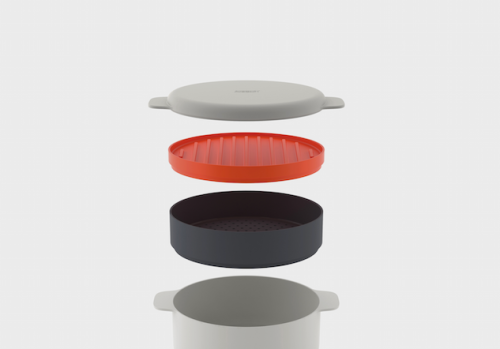Microwave meals
by agwelch
Article for New Design 119 covering work by YouMeUs for JosephJoseph
*
Microwave cuisine doesn’t have a glamorous reputation: it’s all pierce the film, dinner for one, pasty innards hotter than the sun. But it doesn’t have to be that way – after all, the microwave has some great virtues, it is an easy, quick and convenient means of cooking food, and over 80 per cent of UK households own one.

Stackable cooking system
Working with the popular kitchenware brand Joseph Joseph, London-based industrial design and consumer experience company YouMeUs devised a range of microwave cookware, called ‘M-Cuisine’, that would look beyond defrosting and ready meals, changing attitudes to the microwave and helping the brand to take advantage of what, for it, is a new category.
The products within the range include a rice cooker, a stackable cooking system, a ‘cool touch’ dish, and an omelette bowl. All of the pieces deploy Joseph Joseph’s distinctive product language of clean lines, bold colours and a dose of visual wit.
Chris Christou, YouMeUs director, explains that Joseph Joseph approached the consultancy in 2013 having been impressed by the company’s award winning work in kitchen technology, especially for the Kenwood sub-brand KMix. “It was important for us to quickly get up to speed and immerse ourselves into the homeware category and to gain a deeper understanding of what the Joseph Joseph brand stood for,” he says. “This also helped us develop a design methodology that would serve the brand.”
The research process focused on a fundamental question – why is it that microwave cooking has not changed substantively since the devices became a popular domestic purchase through the 1960s and 70s? “Our research was multidimensional. We combined both consumer insight, trends research with ethnographic research,” continues Christou. “This helped us gain an informed understanding around how we live, how we eat, where we eat, together with observational studies centred around product usage, functionality and usability.”

Rice cooker
He continues: “We live in a culture of immediacy, spending less time and less time preparing meals, we demand convenience and eating patterns have fragmented. We felt that it was equally important to understand both how we are living and eating as well as gaining insight into the functional problems associated with product usage. This would allow us to create cookware that was relevant to today’s consumer.”
Joseph Joseph presented YouMeUs with a relatively open brief, leaving it up to the consultancy’s designers to determine product direction. The team’s research revealed that the microwave, used intelligently, can be a very precise and efficient cooking tool. Indeed, for certain foodstuffs, microwaving can be preferential to conventional cooking techniques. Vegetables, for example, typically retain more nutrients when cooked in the microwave rather than, say, by roasting.
In this sense it was the microwave’s capabilities rather than its imitations which informed what elements would constitute the product range. YouMeUs devised a stackable set that allows the cooking of a complete meal – protein, vegetables and potatoes, rice, or pasta – in the microwave. “Different foods require different cooking times, resulting in a lot of dish juggling,” comments Christou. “The stackable design we developed allows you to save cooking time by pausing the microwave and adding layers during the cooking process. A meal making powerhouse for busy families.”
With the rice cooker, rather than inventing a completely new product, the designers were interested in improving every aspect of functionality and aesthetics in the journey from packet to table. Innovations introduced include a rice paddle that also operates as a lock for the lid and the carry handle.
The ‘cool touch’ bowl and dish were designed with convenient warming and eating in mind. The product uses a double-walled structure with an air gap ensuring that the bowl remains cool to the touch. Unlike glass and ceramics, plastics are not affected by the microwave’s electromagnetic radiation so are not themselves heated. The idea was that when taken out of the microwave, the bowl could be comfortably carried around the house – perfect for casual dining or multi-tasking whilst eating your morning porridge.

Cool Touch bowl
The range is completed by an omelette bowl. The microwavable tool serves as both the mixing bowl and cooking vessel in order to increase the convenience of preparation and reduce washing up.
In dealing with a kitchenware product for the microwave, understandably material choice was an important consideration. “When designing microwave cookware, along with the development team at Joseph Joseph we had to select materials that were ‘food safe’ with a high temperature melting point,” adds Christou. “Polypropylene was used for most of the products in the collection. The grill component in the stackable cooking set however uses an SPS polymer as it had to withstand very high temperatures associated with cooking bacon. This was a new material for Joseph Joseph and it did present some tooling and moulding challenges.”
Christou explains that during the design process he was not unduly concerned with the visual communication of the Joseph Joseph brand. Since the brand’s products are distinctive for offering a functional improvement over its rivals’ , Christou felt that creating innovative product concepts that markedly improved the user experience ought to be the priority. “We tried not to think too much about the visual expression or the form language of the object. This would come later on in the design process, once we had an idea,” he says. “Colour, materials and finishes along with some common design details helped to bring the range together.”
The range launched in September 2015 and is available in homeware retailers throughout the country.
love the accidental Partridge (and rhyme) in paragraph 1
love the accidental Partirdge (and rhyme) in paragraph 1